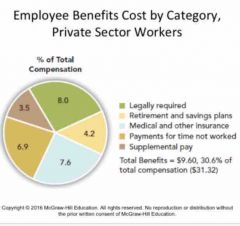![]()
![]()
![]()
Use LEFT and RIGHT arrow keys to navigate between flashcards;
Use UP and DOWN arrow keys to flip the card;
H to show hint;
A reads text to speech;
40 Cards in this Set
- Front
- Back
|
Pay structure |
Relative pay of different jobs and how much they are paid |
|
|
Job structure |
Relative pay of jobs on an organization |
|
|
Efficiency wage theory |
Wage influences worker productivity |
|
|
Rate ranges |
Different employees in same job may have different rates |
|
|
Key jobs |
Benchmark jobs relatively stable and common in many organizations |
|
|
Nonkey jobs |
Unique cannot be compared |
|
|
Job evaluation |
Internal measure of job worth |
|
|
Commendable factors |
Characteristics of a job an organization pays for |
|
|
Pay policy line |
Mathematical expression that describes the relationship between pay and evaluation points |
|
|
Pay grades |
Jobs of similar worth grouped for admin purposes |
|
|
Range spread |
Differences between mom and max in pay grade |
|
|
Compa ratio |
An index of correspondence between actual and intended pay |
|
|
Delayering |
Reducing number of job levels |
|
|
Comparable worth |
Policy that remedies undervaluation of women’s jobs |
|
|
Fair labor standards act |
Minimum wage and overtime pay |
|
|
Inventive effect |
Effect a pay plan has on employee behavior |
|
|
Expectancy theory |
Theory that says motivation is a function of valence instrumentality and expectancy |
|
|
Proncipal |
Seeks to direct another persons behavior |
|
|
Agent |
Acts of behalf of principal |
|
|
Sorting effect |
Effect a pay plan has on composition of work force |
|
|
Merit pay |
Base pay is increased permanently traditional |
|
|
Merit bonus |
Merit pay in form of a bonus |
|
|
Merit increase grid |
Grid that combines an employees performance rating with their position in a pay range to determine size and frequency of pay increases |
|
|
Profit sharing |
Payment on a measure of company performance or profits |
|
|
Stock options |
Employees can buy company stock at a previously fixed price |
|
|
Employee stock ownership plan |
Tax and financial benefits when stock is granted to employees |
|
|
Gain sharing |
Group compensation based on plant or group performance |
|
|
Marginal tax rate |
Percentage of an additional dollar of earnings that goes to taxes |
|
|
Consolidated omnibus budget reconciliation act |
Employers must permit employees to extend health coverage at group rates for 36 months after layoff |
|
|
Pension benefit guaranty corporation |
Agency that garuntees employees a basic retirement benefit in event that company must reduce or terminate pension plans |
|
|
Employee retirement income security act |
Increased fiduciary responsibilities of pension plan trustees portability provisions vesting rights and PBGC |
|
|
Cash balance plan |
Employee sets up individual account for each employee and contributes percentage of salary |
|
|
Summary plan description |
Employers must deceive plans funding eligibility requirements and risks within 90 days |
|
|
Family and medical leave act |
Provide up to 12 weeks unpaid leave for childbirth/ serious family issues |
|
|
Health maintenance organization |
Health care plan that provides benefits on prepaid basis require use of HMO providers |
|
|
Preferred provider organization |
Group of health care providers who contract with employers insurance companies and so forth to provide care at a reduced fee |
|
|
Financial accounting statement |
Requires companies to fund benefits provided after retirement on actual basis rather then pay as you go. And enter future cost obligations on financial statements |
|
|
Red circle vs green circle |
Red- employees make too much compared to average Green- employees make too little |
|
|
COBRA |
Extends health coverage after termination |
|
|
% benefit categories |

Back (Definition) |

